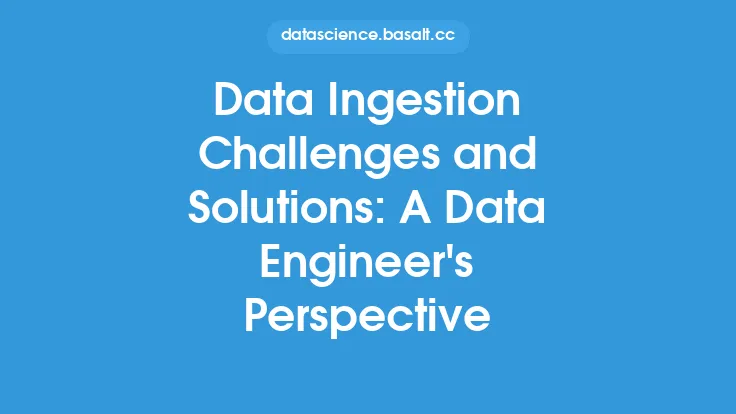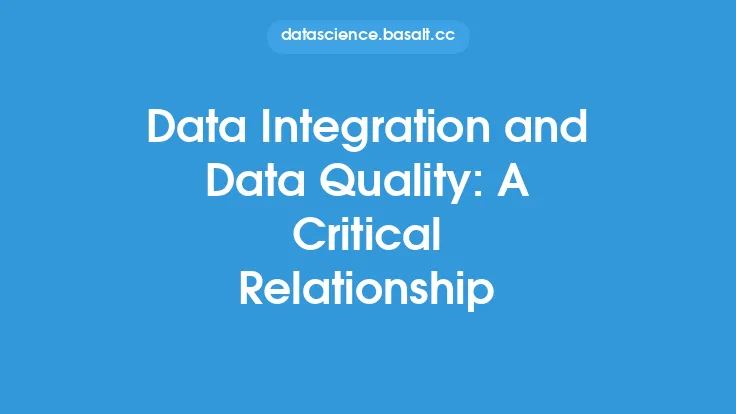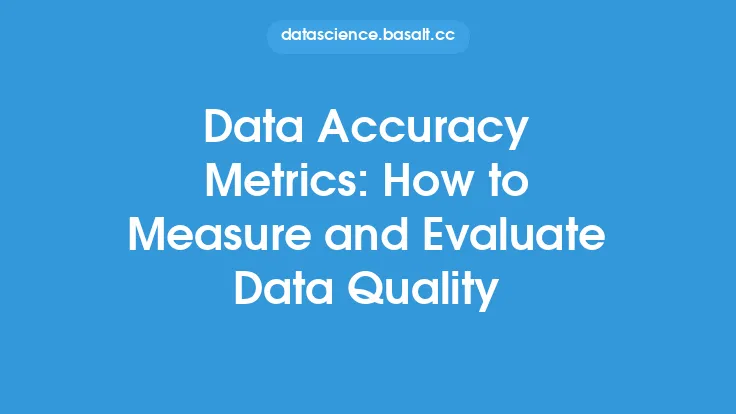Data ingestion is a critical component of the data engineering process, as it enables organizations to collect, process, and analyze large volumes of data from various sources. However, the quality of the ingested data is just as important as the ingestion process itself. Poor data quality can lead to inaccurate insights, flawed decision-making, and a range of other issues that can have significant consequences for businesses and organizations. In this article, we will explore the delicate balance between data ingestion and data quality, and discuss the importance of ensuring that data is accurate, complete, and consistent throughout the ingestion process.
Introduction to Data Quality
Data quality refers to the accuracy, completeness, and consistency of data, as well as its conformity to the requirements of the organization or system that is using it. High-quality data is essential for making informed decisions, identifying trends and patterns, and optimizing business processes. However, ensuring data quality is a complex task, particularly in the context of data ingestion, where large volumes of data are being collected and processed from a variety of sources. Data quality issues can arise from a range of factors, including human error, technical glitches, and inconsistencies in data formatting and structure.
The Impact of Poor Data Quality on Data Ingestion
Poor data quality can have a significant impact on the data ingestion process, leading to a range of issues that can affect the accuracy and reliability of the data. Some of the most common problems associated with poor data quality include data duplication, data inconsistencies, and data loss. Data duplication occurs when the same data is ingested multiple times, resulting in redundant and unnecessary data that can clutter the system and lead to errors. Data inconsistencies arise when data is formatted or structured differently, making it difficult to integrate and analyze. Data loss occurs when data is corrupted, deleted, or otherwise rendered unusable, resulting in gaps and holes in the data that can affect its accuracy and reliability.
Data Quality Checks in Data Ingestion
To ensure the quality of ingested data, it is essential to implement data quality checks throughout the ingestion process. These checks can include a range of activities, such as data validation, data cleansing, and data transformation. Data validation involves verifying that the data is accurate and complete, and that it conforms to the requirements of the organization or system. Data cleansing involves removing or correcting errors and inconsistencies in the data, such as duplicates, invalid values, and formatting errors. Data transformation involves converting the data into a format that is suitable for analysis and processing, such as aggregating data, creating summaries, and generating reports.
Data Ingestion Tools and Data Quality
A range of data ingestion tools are available to support the data ingestion process, including batch processing tools, stream processing tools, and data integration tools. These tools can help to ensure data quality by providing features such as data validation, data cleansing, and data transformation. For example, batch processing tools can be used to validate and cleanse data in batches, while stream processing tools can be used to process and analyze data in real-time. Data integration tools can be used to integrate data from multiple sources, and to transform it into a format that is suitable for analysis and processing.
Best Practices for Ensuring Data Quality in Data Ingestion
To ensure the quality of ingested data, it is essential to follow best practices throughout the ingestion process. Some of the most important best practices include implementing data quality checks, using data ingestion tools, and monitoring data quality in real-time. Implementing data quality checks involves verifying that the data is accurate and complete, and that it conforms to the requirements of the organization or system. Using data ingestion tools involves selecting tools that provide features such as data validation, data cleansing, and data transformation. Monitoring data quality in real-time involves tracking data quality metrics, such as data accuracy, data completeness, and data consistency, and taking corrective action when issues arise.
The Role of Data Governance in Data Ingestion and Data Quality
Data governance plays a critical role in ensuring the quality of ingested data, as it provides a framework for managing and overseeing the data ingestion process. Data governance involves establishing policies, procedures, and standards for data management, as well as assigning roles and responsibilities for data stewardship. A well-defined data governance framework can help to ensure that data is accurate, complete, and consistent, and that it conforms to the requirements of the organization or system. It can also help to prevent data quality issues, such as data duplication, data inconsistencies, and data loss, by providing a clear understanding of data ownership, data accountability, and data stewardship.
Technical Considerations for Data Ingestion and Data Quality
From a technical perspective, ensuring data quality in data ingestion requires a range of considerations, including data formatting, data structuring, and data processing. Data formatting involves ensuring that the data is in a format that is suitable for analysis and processing, such as CSV, JSON, or Avro. Data structuring involves organizing the data into a structure that is suitable for analysis and processing, such as a relational database or a NoSQL database. Data processing involves transforming the data into a format that is suitable for analysis and processing, such as aggregating data, creating summaries, and generating reports. Additionally, technical considerations such as data storage, data security, and data scalability must also be taken into account to ensure that the data is properly managed and maintained throughout the ingestion process.
Conclusion
In conclusion, data ingestion and data quality are closely intertwined, and ensuring the quality of ingested data is essential for making informed decisions, identifying trends and patterns, and optimizing business processes. By implementing data quality checks, using data ingestion tools, and following best practices, organizations can help to ensure that their data is accurate, complete, and consistent. Additionally, data governance and technical considerations such as data formatting, data structuring, and data processing must also be taken into account to ensure that the data is properly managed and maintained throughout the ingestion process. By striking a delicate balance between data ingestion and data quality, organizations can unlock the full potential of their data and drive business success.





